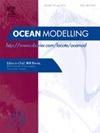Global tsunami modelling on a spherical multiple-cell grid
IF 3.1
3区 地球科学
Q2 METEOROLOGY & ATMOSPHERIC SCIENCES
引用次数: 0
Abstract
A model of shallow water equations (SWEs) on a spherical multiple-cell (SMC) grid of 4-level (2.5–5–10–20 km) spatial resolutions is used to simulate tsunami propagation on global ocean surfaces. The unstructured SMC grid retains rectangular cells of the longitude-latitude grid so that efficient finite-difference schemes could be used. It also supports multi-resolutions like mesh refinement to resolve small islands and coastline details while keeping models compact enough to fit into available computers. Two earthquake-induced tsunami cases are simulated and compared with available observations. Results indicate that the modelled tsunami arrival times agree well with observations while tsunami wave heights are underestimated, particularly the observed runups on remote coastal lands. Possible reasons for this underestimation include the smoothing scheme used to suppress numerical oscillations and the missing of initial kinetic energy input from the earthquakes. Another reason is the limitation of the SWEs to describe coastal bores and breaking waves in coastal waters. A possible tsunami scenario induced by a landslide in the Canary Islands is also simulated to assess its potential impact on Atlantic coastal regions. Model results indicate that this kind of tsunami may cause severe damage to local areas but its effects on far fields, like the UK and American coastal regions are small. As the initial landslide disturbance is overly simplified, this study does not give a true representation of a real landslide tsunami but rather a qualitative assessment of its impact on the Atlantic Ocean. More realistic initial condition and improved model representation of coastal processes are needed for further studies of this possible landslide hazard.
在球形多单元网格上建立全球海啸模型
采用空间分辨率为 4 级(2.5-5-10-20 公里)的球形多单元网格(SMC)上的浅水方程(SWE)模型,模拟海啸在全球海洋表面的传播。非结构化 SMC 网格保留了经纬度网格的矩形单元,因此可以使用高效的有限差分方案。它还支持多分辨率,如网格细化,以解决小岛屿和海岸线细节问题,同时保持模型足够紧凑,以适应现有计算机。模拟了两个地震引发海啸的案例,并与现有观测数据进行了比较。结果表明,模拟的海啸到达时间与观测结果吻合,但海啸波高被低估了,特别是在偏远沿海地区观测到的海啸波高。造成这种低估的可能原因包括为抑制数值振荡而采用的平滑方案,以及地震初始动能输入的缺失。另一个原因是,SWEs 在描述沿岸水域的沿岸膛线和断裂波方面存在局限性。还模拟了加那利群岛山体滑坡可能引发的海啸,以评估其对大西洋沿岸地区的潜在影 响。模型结果表明,这种海啸可能会对局部地区造成严重破坏,但对远距离地区,如英国和美国沿海地区的影响较小。由于初始滑坡扰动过于简化,这项研究并不能真实地反映真实的滑坡海啸,只能对其对大西洋的影响进行定性评估。在进一步研究这种可能的滑坡灾害时,需要更真实的初始条件和更好的沿岸过程模型。
本文章由计算机程序翻译,如有差异,请以英文原文为准。
求助全文
约1分钟内获得全文
求助全文
来源期刊

Ocean Modelling
地学-海洋学
CiteScore
5.50
自引率
9.40%
发文量
86
审稿时长
19.6 weeks
期刊介绍:
The main objective of Ocean Modelling is to provide rapid communication between those interested in ocean modelling, whether through direct observation, or through analytical, numerical or laboratory models, and including interactions between physical and biogeochemical or biological phenomena. Because of the intimate links between ocean and atmosphere, involvement of scientists interested in influences of either medium on the other is welcome. The journal has a wide scope and includes ocean-atmosphere interaction in various forms as well as pure ocean results. In addition to primary peer-reviewed papers, the journal provides review papers, preliminary communications, and discussions.
 求助内容:
求助内容: 应助结果提醒方式:
应助结果提醒方式:


